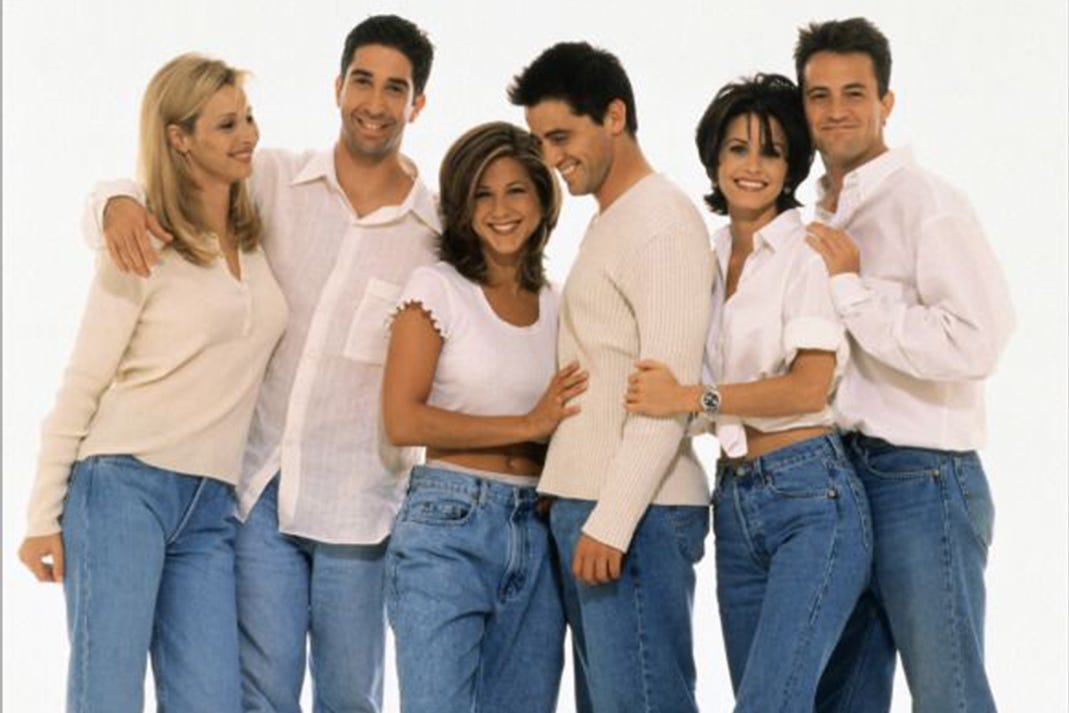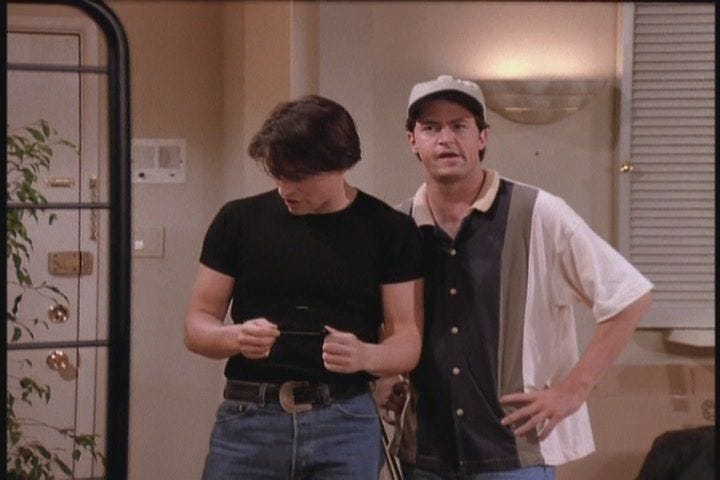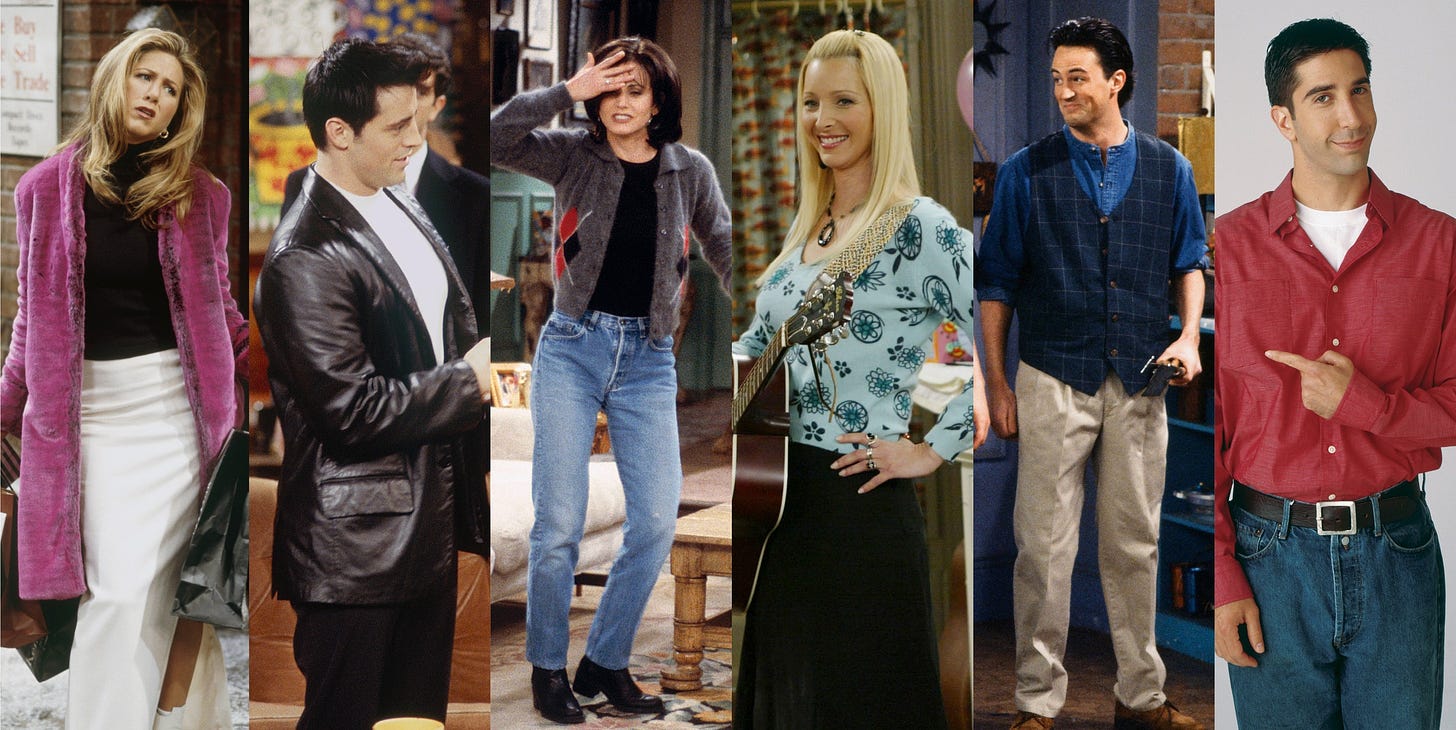If I said to you “picture a show that’s set in the mid-90s where a bunch of twenty-somethings navigate their lives and relationships and constantly hang out in their favorite coffee shop, set in New York City,” well, you’d know I was talking about Friends. But if you had somehow never heard of Friends, you’d probably have a picture of something very different than the show we got. You might picture a bunch of stylish Gen Xers trying to balance the era’s fixation on authenticity with the need to pay the rent. You might imagine them going to underground clubs and hearing music by independent artists on the come up. You might picture them in clothing that reflected the styles of the era, not necessarily flannel and bomber jackets but something that expressed at least a modicum of interest in contemporary fashion. You might think of their coffee shop as being a cool out-of-the-way place where the connoisseurs go, someplace with low lighting and a savvy clientele. You might assume that the New York they move around in is a hip site of artists and thinkers, the outsider’s New York that’s been dramatized in so many television shows and movies.
Of course, none of that is true. The show feels like it takes place out of time, its characters are uncool, they reflect no definable generational sensibility at all, nowhere they go appears to be remotely hip or underground, they have seemingly no interest in the culture of the moment, they wear formless clothes that manage somehow to be both garish and yet make no particular fashion statement, their coffee shop is an ugly and haphazard place that takes as its name a stupid and broad pun, and their facsimile of New York has neither any big-city grime nor any identifiable regional character. The show does not merely lack edge, it appears so resistant to anything appearing edgy that it’s content to exist as a shapeless blob that comments on nothing beyond the inane chatter of the characters and their constant low-stakes dramas. Friends debuted in the mid-1990s and ended in the mid-2000s, but it reflects almost nothing about its era - like most sitcoms of its time, it very rarely connected to current events, but more it seemed to defy the impulse to dramatize or comment on any of the trends or social commonplaces of its day. It goes without saying that the show was rabidly apolitical, but it’s more than that; it’s a cultural object that exists outside of culture. The best symbol for the show is one of the dress shirts worn by its male characters - so baggy and loose that it has no definable shape, made in some bright color that overwhelms petty concerns like style, of no era, signifying nothing.
I know a lot of people love Friends, and the intent of this post is genuinely not just to shit on something others love. I personally don’t enjoy the show, but my purpose here is not to argue that it’s bad or examine why I think it’s bad. No, I have a much deeper interest in its anti-style, in its studied indifference to trends in popular culture or, indeed, to time itself. What’s mysterious is why Friends was what it was, why it was so utterly, defiantly resistant to having an identity, why it was so relentlessly bland.
I feel bad here because I’m in debt to an argument that I can’t find. Years ago I read a smart piece online with a very good central question - why is Friends so uncool? Why does it seem to almost aspire to being uncool? I want very much to share the piece and give it adequate credit, but I have searched and searched and can’t find it. I’ve got little to go on other than that it’s about how Friends was deeply and strangely uncool, wasn’t published in a big publication, and came out at least five years ago, probably more. The piece pointed out the general condition that I’m describing here and concluded that this resistance to style, fashion, and generational position, to portraying any of the good things about New York in a show set in New York - to being cool - had to be intentional.
The clothes are a good subject to define what I don't mean. I'm emphatically not saying that the clothes don't look stylish in comparison to contemporary definitions of style, that they are out of fashion. I'm saying that they never were in fashion. I'm saying that they exist in defiance of fashion. To the extent that they ever became fashionable, it's because the slow influenced the culture, not the other way around. There's plenty of TV and movies from the era where the clothes don't look great thanks to changing tastes, but where I can still identify them as capturing a particular vision of taste. Here, it's like the costuming department had a specific mandate to express no taste.
I’ve been reading Chuck Klosterman’s 2022 book The Nineties, which was published last year, and he makes similar points. Klosterman writes
this wasn’t as straightforward as attracting twentysomething viewers by making a show about twentysomething people. Friends became the model for how to pinpoint generational concerns without directly recognizing that generations exist…. It tended to reside in a generic universe that did not intersect with the cultural moment…. The cast did not purposefully dress in a way that tied them to the time period, although sometimes that happened by accident…. The series’ overall trajectory is a catalog of what would now be seen as a collection of cliché Gen X concerns, mainstreamed through avatars who didn’t look or sound like cliché Gen Xers.
Both the essay I can’t find and Klosterman note that, in the episode where the gang is really excited to go see a concert, the band they’re seeing is Hootie and Blowfish. I’ve got lots of affection for Hootie, myself, and they are technically a 90s band. But they aren’t a 90s band - not like, say, one of the major grunge bands. They sold so many damn albums in part by being, like Friends, outside of their own time. Hootie’s superpower was offering era-defying middle-of-the-road midtempo rock’n’roll, the kind of rock that you wouldn’t stick any modifier in front of. And anyway, if you had any interest in making the characters in the show you’re making in the 1990s look cool or hip or minimally interested in having taste, the absolute last band you’d nominate would be Hootie and the Blowfish. It’s a defiant act, really, a rejection of the very notion of being cool, a show about a bunch of NYC 27-year-olds who exclusively watch VH1.
You could contrast Friends with Seinfeld, another NBC Thursday night show that’s about the foibles of a bunch of white people with vague jobs and financial situations getting into pickles in New York, but which no one would ever describe as generic. Seinfeld takes advantage of New York more than Friends does and captures more of the city’s character, which isn’t hard to do considering that when Friends left the apartments of its characters and the coffee shop, it tended to head to featureless offices or a restaurant kitchen or a department store. Seinfeld’s New York feels both more real and more spacious. (The nightclub where Jerry performs has more character than any location in Friends and it’s barely on screen.) There is, though, a consistent line of complaint that the Seinfeld’s NYC is a whitewash, one where most of the characters of color are broad caricatures. And I don’t think that’s entirely wrong. Nor can you say that the Boomer characters of Seinfeld reflected much in the way of current culture - their older age, Kramer’s vintage outfits, the show’s indifference to popular music, Jerry’s pioneering normcore clothing style, and many other elements of Seinfeld point to a similar lack of interest in portraying a given generational experience or moment in time.
And yet I don’t feel like Seinfeld is empty of signifiers in the style of Friends. Why? I think it mostly comes down to the fact that the show has such a singular point of view, that its sense of humor is so distinct, and that it takes such a remarkably particular and cranky perspective on the absurdities of its characters and their world. Seinfeld premiered in the 1980s but mostly aired in the 1990s, yet I wouldn’t call it a particularly 90s show in the way of, say, My So-Called Life. But it’s too spiky and mannered to be as lacking in personality as Friends. (It’s also, I think, often too specifically a Jewish point of view to be that featureless, although I find that some people are sensitive about saying that Seinfeld has a particularly Jewish character.) Most people love Seinfeld, but a vocal minority hates it, finding the humor too mean and self-impressed. It’s hard to imagine really hating Friends, in contrast, thanks in large measure to its own comedic style, which is defined by snarky but inoffensive put-downs, constant comic misunderstandings, and rote wordplay. There are plenty of critical pieces about Friends that you can find out there, but none of it feels particularly passionate. What would you get passionately angry about?
It’s here that I’ll admit that my question isn’t really much of a question at all - as Klosterman alludes, the reason Friends is so unconquerably bland and resistant to cultural positioning is commerce. I’ll acknowledge the cast’s talent and great chemistry without hesitation. But surely the show’s real genius lay in exactly the phenomenon I’m describing: by refusing to reflect on a specific cultural or generational experience, through its commitment to not capturing anything particular or getting overly invested in depicting reality, Friends made a space for the widest possible audience. Cool and fashionable Gen Xers living and loving in mid-90s Manhattan sounds like a great draw to me, but then that setup flatters my interests. It wouldn’t flatter the interests of everyone, even in the mid-90s. I’m actually not a huge Seinfeld fan myself, but Seinfeld’s immense success demonstrated that a show could be fractious and mannered and still reach a vast audience. Friends demonstrated the opposite, which is the commercial possibilities of a blank canvas. People could project themselves into the show no matter who they were. And they still do. Friends is a big success on streaming, but its platonic form is found on old-fashioned TV in syndication. After all, while the plot changes a little (specifically through the pairing up of characters), it’s very easy to jump randomly between seasons; nothing ever really changes.
So I suppose the only enduring mystery here is the boring old mystery of taste - why people like something I don’t like, why the show never suffered for its utter lack of character and disdain for embodying a vision of a particular moment, its broad and repetitive humor and its endlessly recycled plotlines. Taste is mysterious, arbitrary, and fickle, and as with all matters of taste I have no interest at all in trying to change anyone’s mind here. This isn’t a snobs versus the people thing; Seinfeld, after all, was just as popular, and had a larger cultural footprint. And even I’m not immune to the charms of a bunch of attractive actors who’ve been at it for years playing the hits, delivering their one-liners in a setting that’s refreshingly static. I think people find Friends comforting, for the same reason that they like its classic, awful theme song, which is similarly unchallenging, peppy, and poppy. You hear the jangly guitars and you know exactly what’s coming, something safe, competent, and untainted by change.
My So-Called Life and Friends both debuted in 1994. The former is a delicate portrayal of quintessentially late-Gen Xer characters, operating in a world that’s unmistakably of its era, reflecting the fashions and music and cultural id of its own time. Those who liked the show loved it, and it became a cultural touchstone that many creators still refer to as an influence today. It was also canceled after a single season.







Imagine a version of Friends that was actually a combination of Reality Bites, Metropolitan and MTV's Real World....
Friends is generic by its soundstage, studio audience, catch-phrase-y existence.
I think though it's more 90s in its look than you give credit for: on the women especially. The makeup, eyebrows, necklaces. Very very 90s. But the 90s of suburban malls, not NY high fashion.
Whether its characters were uncool and whether it communicated a New York flavor depends on how old you were and where you lived when it was airing. To a junior high kid in flyover country, certainly Rachel could pass for cool with her (intermittent) fashion-industry jobs and her trend-setting haircuts. Joey too. Ross was, of course, aggressively uncool; his generally simpering tone, and the utter implausibility of Rachel pining for him, are big impediments to me enjoying that show. Phoebe communicated a boho sensibility to suburban kids who had no real idea what hippie-ish big city counterculture actually looks like. Sit-down, hang-out coffee shops were really just taking off around the country in the early to mid 90s, even if they were old hat in New York, so that idea was new and hip-seeming to many people as well. I'm sure it was laughably inauthentic to people who actually know New York, but I do think it maybe communicated a tiny taste of NY flavor to people who knew nothing about the place, in terms they could understand and find appealing.